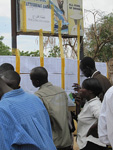
Election results for Sudan’s National Assembly seats were released last week by the National Elections Commission, or NEC, showing significant gains by the ruling NCP and further marginalization of opposition parties in both the North and the South.
While the results of the presidential level election – and the fraud, rigging, and intimidation that produced them – captured headlines, far little attention has been drawn to the outcome of the legislative races. However, the make-up of Sudan’s National Assembly could have a profound impact on events in the country before and after the referendum on southern secession next year.
These preliminary numbers (about 20 races have yet to be determined), show the NCP winning 73 percent of the decided seats and the SPLM, 22 percent. This is a significant shift in the political dynamic between the two ruling parties when compared to the percentage of seats the NCP (52 percent) and the SPLM (28 percent) were allocated under the CPA.
That the SPLM’s percentage of seats has fallen below 26 percent is significant because that is the proportion of seats the party needs to block any attempt at amending the constitution (which requires 75 percent of the assembly’s approval). Similarly, the NCP’s gains have brought it that much closer to being able to change the constitution to its liking, if it is able to pull together a coalition of parties for those few extra votes. (Remember, the South’s vote for secession is right around the corner so the NCP’s legislative dominance, and the potential acts of malfeasance that could accompany this power, is disconcerting.)
Opposition parties in both the North and the South suffered setbacks. The percentage of seats held by northern opposition parties fell dramatically from 14 percent to 3.9 percent, casting a pall over the North’s democratic potential—especially when looking at Khartoum’s strong-handed stifling of opposition figures and media since elections ended. Looking just a little further down the road, this discrepancy will be even starker once the southern members are no longer part of the body, following the likely secession of the South next year. (But that’s another blog post…) In the South, opposition party SPLM-DC only earned two seats, or 0.4 percent—a reminder of the similarly strong-handed methods undertaken by the SPLM to ensure its political monopoly.
Marc Gustafson, who analyzed the results on Making Sense of Darfur, summed up the post-electoral reality in Sudan nicely:
Some have argued that, as well as being a treaty to end war, the Comprehensive Peace Agreement helped shepherd Sudan into the nascent stages of multi-party development, providing fertile ground for democratic advancement and party cooperation. This argument is becoming more difficult to make in the wake of Sudan’s legislative and presidential elections. Sudan is now better classified as a two-party state where democracy takes a back seat to the authoritarian regimes that control their respective regions.
Photo: Crowd gathers around poll results in southern Sudan (Enough/Maggie Fick)

